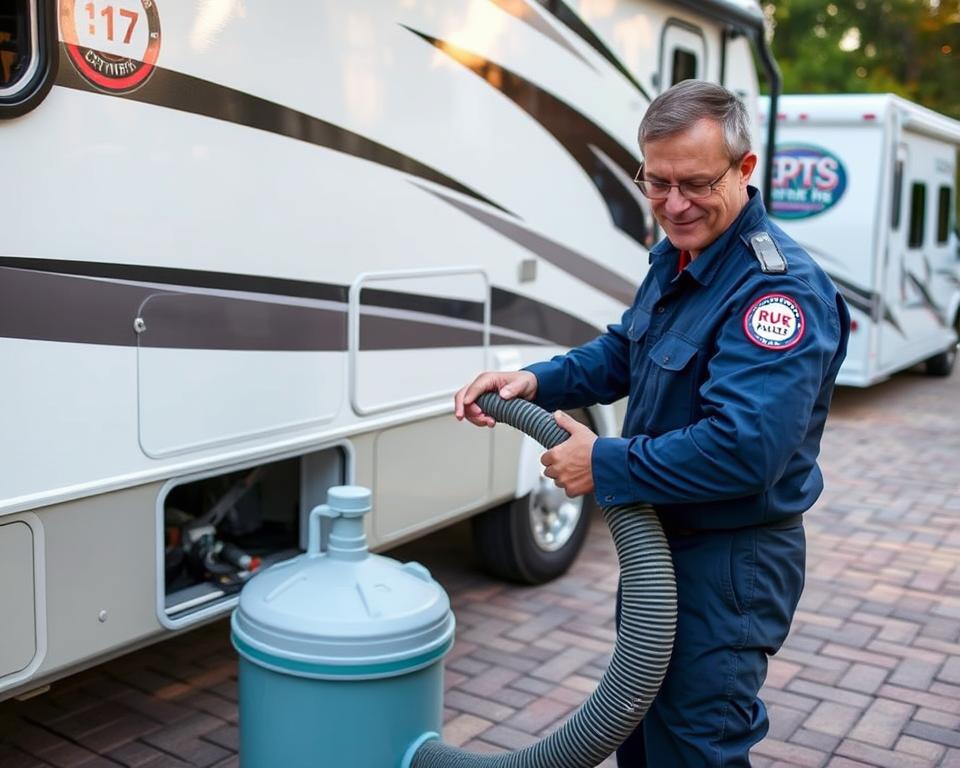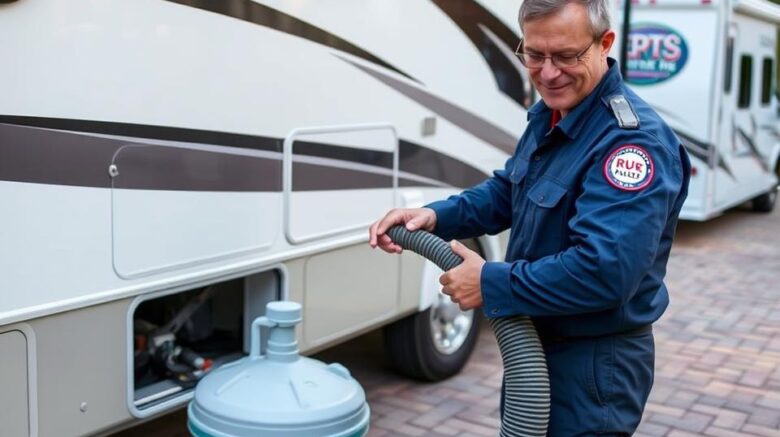RV Septic Removal Guide: Easy Steps & Tips
Curious about the importance of correct RV Septic removal for a smooth camping trip? It’s not just for ease; it’s vital for a hygienic environment during your journey. Throughout this guide, easy-to-follow steps and hints from pros will be shared. These will help you handle your RV’s Septic system with ease. We’re about to explore the necessity of RV Septic removal, which is more crucial than it may appear with RV water tank and pump!
Principal Conclusions
- Understanding the necessity of effective RV Septic systems.
- Straightforward procedures for RV Septic removal to improve sanitation.
- Identifying suitable dump stations for waste disposal.
- Post-dumping cleanup guidelines for a hassle-free experience.
- Typical mistakes to avoid during RV waste disposal.
- Clues that you may need professional RV sanitation services.
Understanding RV Septic Systems
RV Septic systems are key for hygiene during travel. They consist of two main reservoirs: the gray and black water tanks. Knowing the purpose of each is important for ensuring cleanliness and managing waste properly.
The gray water tank gathers water from sinks and showers, while the black water tank stores toilet waste. The capacity of these tanks influences travel duration before requiring service. A usual RV might have a 30- to 50-gallon gray water tank and a 20- to 40-gallon black water tank.
Proper RV Septic systems dramatically boost the travel experience. It’s necessary to monitor tank levels to stop overflows. Routine upkeep and cleaning extend these systems’ lives, guaranteeing problem-free trips. Understanding the right way and time to dump the tanks is key for optimal waste management.
| Tank Type | Role | Typical Capacity (Gallons) |
|---|---|---|
| Gray Water Tank | Captures wastewater from sinks, showers, and appliances | 30 – 50 |
| Black Water Tank | Holds sewage waste from the RV toilet | 20 – 40 |

Knowing RV Septic systems not only improves camping joy but is also vital for the environment. Knowledge in these systems contributes to ease and comfort on journeys.
The Value of Proper RV Septic Removal
Correct RV Septic removal is critical for a seamless experience in your recreational vehicle. Without it, you might face tank overflows, unpleasant scents, and sewer backups. These problems are not merely inconveniences—they can lead to expensive repairs and health hazards.
To keep your system in top shape, regular RV Septic tank pumping is a necessity. It avoids waste buildup, maintaining efficient operation. Neglecting this can cause your system to fail, detracting from the joy of RV travel.
Choosing reliable RV sanitation services is key to managing your waste efficiently. Such services make sure waste is handled correctly, minimizing environmental harm and preserving your living space clean. This way, you can enhance your RV living, free from waste disposal worries.
Prepping for RV Septic Removal
Getting ready for RV Septic system service is important for a smooth operation. First, collecting all necessary tools and materials. Double-check you have rubber gloves, durable sewer hoses, sanitation wipes, and a bucket for waste. This setup is critical for a successful sewage disposal process.
It’s vital to understand your RV’s layout. Get to know where the dump valves and sewer hose connections are. This knowledge saves time and stops mishaps during the cleaning of the RV holding tank. Always focus on safety by wearing gloves and protective gear to stop contamination.
Use this checklist to ensure you’re fully prepared:
- Rubber gloves
- Sturdy sewer hoses
- Sanitation wipes
- Waste container
- Safety goggles (optional)
- Protective shoes
When heading to a dump station, have your equipment organized and check the tank levels before you leave. Adequate preparation is crucial to a successful experience and maintaining your RV’s Septic system effectively.
Locating Suitable Dump Stations
Identifying suitable dump stations is essential for managing RV waste on your travels. Sites like SaniDumps, Campendium, and RVDumps can greatly aid in this task. These resources make it simple to find nearby facilities.
They let you search by location, read user reviews, and check the services offered by each station. This step secures you have access to the needed amenities during your journey.
Bear in mind, it’s vital to practice good etiquette at dump stations. This helps maintain cleanliness for everyone. Here are some tips:
- Always clean up after yourself and leave the area tidy.
- Follow posted rules and regulations at each dump station.
- Be mindful of peak hours and try to avoid overcrowding.
- Notify staff of any issues or concerns regarding the facility.
Leveraging available tools and caring for shared facilities guarantees a smooth RV waste disposal process. Your travels will be more pleasurable and easygoing.
RV Septic Removal Step-by-Step
Managing RV Septic removal properly is essential for a trouble-free waste disposal journey. By observing these steps, you’ll find the process smoother and your RV’s plumbing system will stay in good condition for longer.
- Determine your RV black water tank’s location first. This knowledge speeds up the dumping sequence.
- Connect your hose to the dump station slot. Verifying a tight fit is crucial to stop spills.
- Start with servicing the RV black water tank. Open its valve to discharge the waste into the dump station. Let complete drainage.
- Once it’s empty, proceed to clean the RV holding tank. Shut the valve, then fill the tank with clean water.
- Flush out the tank by reopening the valve, using the fresh water for cleansing.
- Consider a specialized tank cleaner or deodorizer for extra sanitation. These products offer a more pleasant environment and dissolve waste more effectively.
- Finally, disconnect and cleanse the hose thoroughly. This step is vital in preventing future blockages and odors.
Observing this guide secures successful RV Septic removal. Committing to regular upkeep, including scheduled services and thorough cleanings, is essential for optimal RV function.
Cleaning Up After Dumping
After you’ve emptied RV waste, tidying up becomes important. First, ensuring the sewage hose is completely rinsed out. This step is key for hygiene and to stop leftover waste from creating smells or contamination. For better cleanliness, use a hose dedicated for RV sanitation services.
Then, sanitize all tools and equipment involved in cleaning the RV holding tank. Gloves, hoses, and any additional tools used in the process must be cleaned. This prevents any risk of contaminating your fresh water supply.
After cleaning and sanitizing, refill the fresh water tank. This readies your RV for its next use and removes any lingering contaminants. A thorough post-dumping cleanup will keep your RV safe and ready for more adventures.
Maintaining Your RV Septic System
Keeping your RV’s Septic system well-maintained is essential for a smooth journey. Routine maintenance prevents blockages and improves sewage system efficiency. Apply these tips for efficient RV waste management.
- Use RV-approved toilet paper to reduce clogging.
- Inspect hoses regularly for any signs of wear or leaks.
- Incorporate tank treatments every few weeks to stop odor build-up and solid accumulation.
- Flush your system with plenty of water after dumping to guarantee complete waste removal.
- Avoid putting any non-biodegradable materials in the toilet.
Preventive sanitation services for your RV can bring a healthier living space and improve your camping experience. Diligently caring for your Septic system not only extends its life but also preserves your RV’s interior smelling fresh.
When to Call a Pro for RV Septic
Recognizing signs that you need professional RV Septic services is crucial. It can cut you time, money, and stress. A frequent sign is a lingering odor coming from your RV’s waste system. If foul smells persist after dumping, it’s time for a detailed RV Septic tank inspection.
Sluggish flow in your sinks and shower suggests a blockage or buildup. This demands a professional to address it successfully. Visible leaks around the Septic tank or hoses are a more urgent issue. They pose environmental hazards and call for immediate professional intervention.
Requesting timely help is essential for your RV Septic system’s health. Ignoring these warnings can result in major issues and high repairs in the future.
Common Mistakes in RV Waste Disposal
RV owners often deal with difficulties with waste management. Recognizing usual errors can significantly enhance the disposal process, making journeys more pleasant. A typical misstep involves disposing of waste in undesignated areas. This can result in fines and harm the environment.
Many neglect to completely clear out their tanks. It’s important to perform proper Septic pumping to prevent odors and spills. Skipping regular waste level checks results in backups, adding to the inconvenience.
Confusing black and gray water tanks creates problems. This mix-up happens if tanks are not labeled or understood correctly. Understanding your RV’s Septic system is key to avoiding this issue and maintaining proper sanitation.
To better manage waste, keep these suggestions in mind:
- Always dump at designated dump stations.
- Check tank levels regularly to guarantee timely RV Septic tank pumping.
- Label your tanks clearly to avoid mistakes.
- Research waste disposal regulations in different locations.
Improving RV Waste Disposal
Upgrading your RV waste disposal system can reduce the burden of Septic maintenance. An efficient solution is a macerator pump. This device allows waste to move easily through thinner hoses, streamlining the process. By reducing dumping time and mess, it becomes a favorite for RV veterans.
Adopting cutting-edge products can make waste disposal both effective and convenient. Portable waste tanks, for instance, offer added capacity when dump stations are out of reach. It also helps to engage high-quality RV sanitation services, ensuring your system in optimal shape.
Consider incorporating the following upgrades into your RV waste disposal routine:
- Regular inspections of hoses and connections to avoid leaks and maintain proper sealing.
- Utilizing enzyme-based products that help in breaking down waste and odors.
- Implementing a consistent cleaning schedule for tanks and hoses after each trip.
With the proper techniques and tools, managing RV Septic systems becomes more efficient. Effective waste disposal enhances your RV experience, removing common obstacles. Equipped with the proper knowledge, RV sanitation management can be easy.
Bringing It All Together
Understanding the RV Septic removal process is essential for enthusiasts. Correct disposal keeps both your vehicle and environment pristine, improving your camping joy. It’s essential to service your RV’s sanitation services regularly.
Key steps for proper Septic removal are critical on your journeys. Find appropriate dump stations and observe safe disposal techniques. Attention to waste management profoundly impacts your travel experiences. For any issues, consulting professionals ensures keeping your RV’s condition.
Focus on sanitation enables you enjoy the open road’s freedom, minus sanitary worries. Enjoy your trips and stay safe on your adventures!
